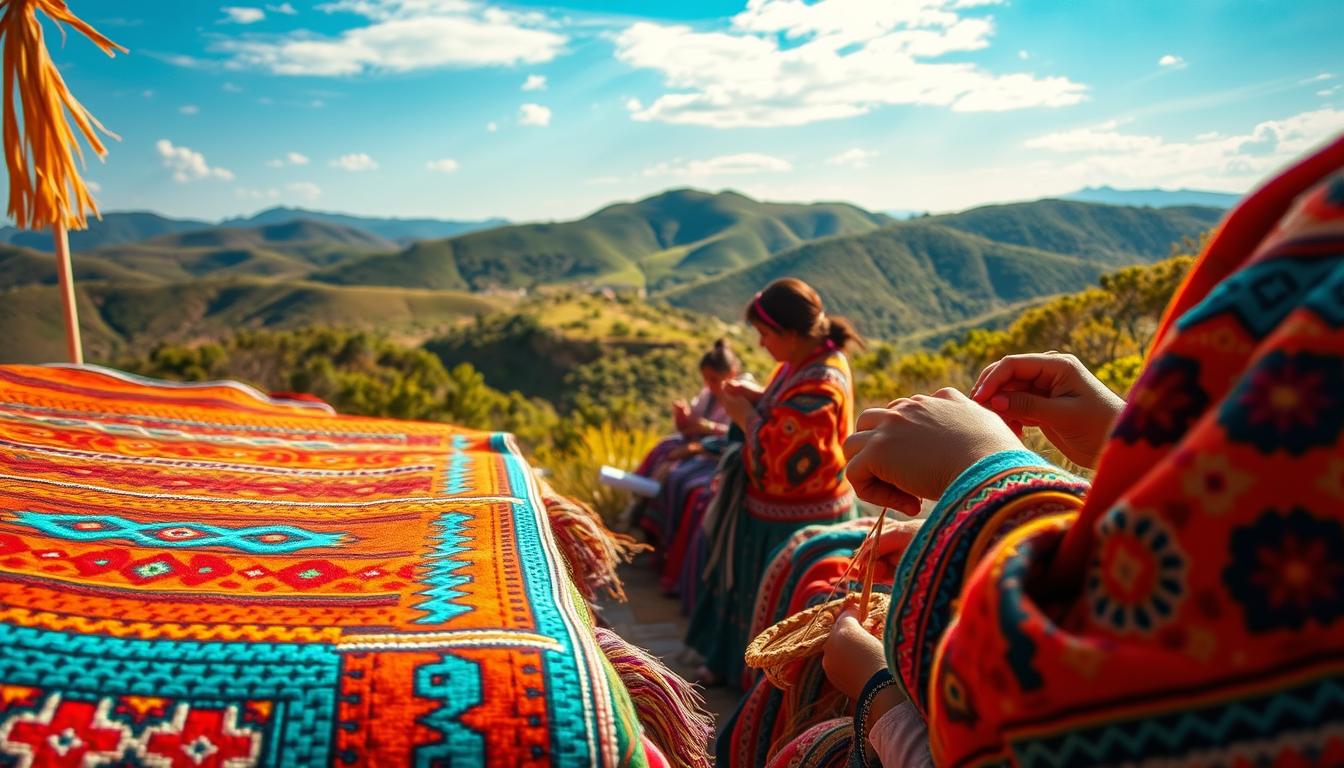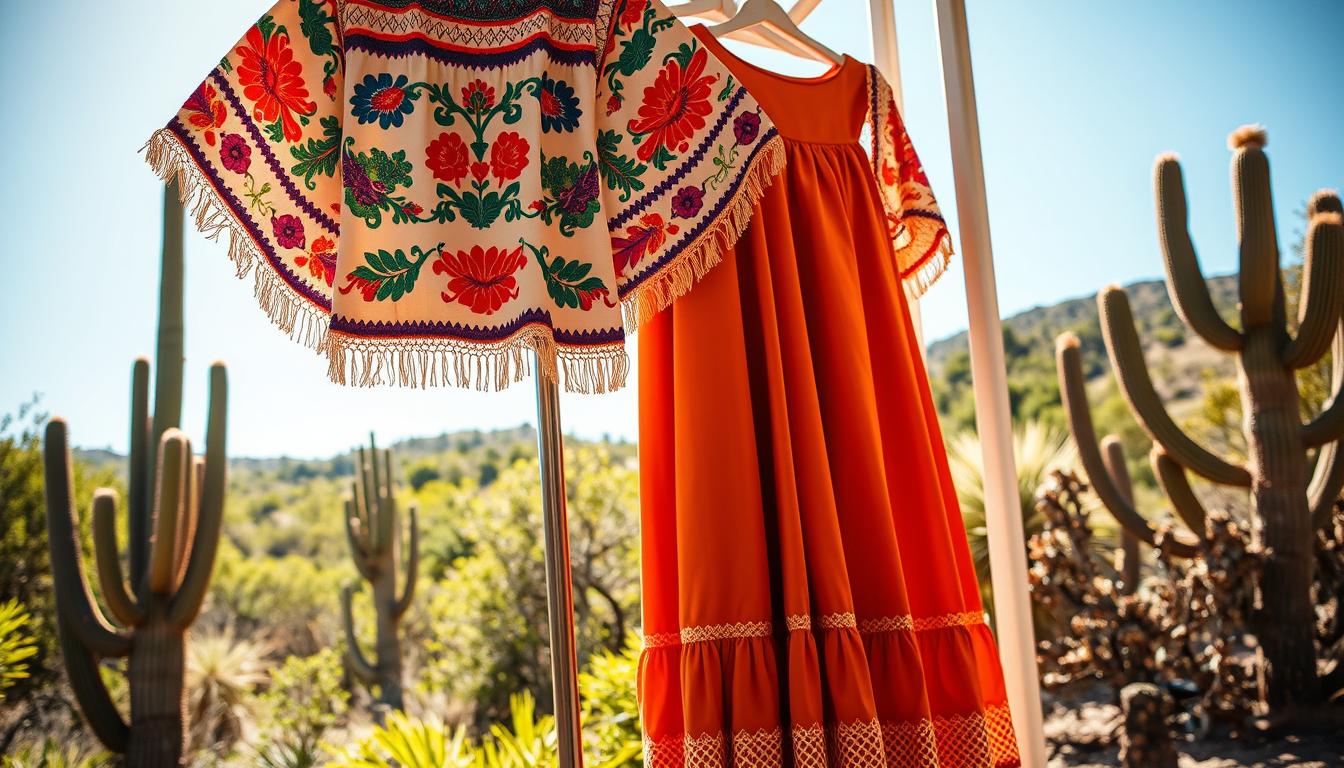The rich heritage of Mexican culture clothing is a testament to the country’s diverse history and traditions. From the intricate textiles of the ancient civilizations to the modern-day attire, Mexican clothing is a vibrant reflection of its people’s identity.
Traditional Mexican clothing is not just about aesthetics; it’s deeply rooted in the country’s history and cultural practices. The use of vibrant colors, unique patterns, and handmade techniques makes Mexican textiles truly distinctive.
Key Takeaways
- Understanding the historical context of Mexican culture clothing.
- Exploring the significance of textiles in Mexican traditions.
- Discovering the unique elements that make Mexican clothing vibrant.
- Learning about the cultural practices behind traditional Mexican attire.
- Appreciating the handmade techniques used in Mexican textiles.
The Rich Heritage of Mexican Textiles
Mexican textiles boast a rich heritage that spans centuries, reflecting the nation’s complex cultural tapestry. The history of these textiles is a story of evolution, influenced by various cultures and historical events.
Pre-Hispanic Origins
The origins of Mexican textiles date back to pre-Hispanic times, when indigenous communities developed sophisticated weaving techniques. Ancient civilizations such as the Aztecs and Mayans created intricate fabrics that were not only functional but also held significant cultural and spiritual meaning.
These early textiles were made from natural fibers like cotton and agave, often dyed with vibrant colors derived from plants and insects. The designs and patterns woven into these fabrics told stories of mythology, daily life, and spiritual beliefs.
Colonial Influences
The arrival of Spanish colonizers in the 16th century brought significant changes to Mexican textiles. European techniques and materials were introduced, blending with indigenous traditions to create a unique fusion. This period saw the introduction of new dyes, such as cochineal, and the adoption of European looms.
The impact of colonialism on Mexican textiles can be seen in the table below, which highlights key differences between pre-Hispanic and colonial-era textiles.
| Characteristics | Pre-Hispanic Textiles | Colonial-Era Textiles |
|---|---|---|
| Fibers Used | Cotton, Agave | Cotton, Wool (introduced by Europeans) |
| Dyes | Natural dyes from plants and insects | Inclusion of cochineal and other European dyes |
| Weaving Techniques | Backstrap loom, primitive looms | Introduction of European looms |
This blend of influences enriched Mexican textiles, creating a distinct cultural identity that continues to inspire contemporary textile artists.
Traditional Mexican Culture Clothing
From the intricate embroidery to the bold colors, traditional Mexican clothing is a reflection of the country’s history and identity. This rich cultural heritage is evident in the diverse array of garments that have been passed down through generations.
Iconic Garments
Among the most iconic elements of traditional Mexican clothing are garments like the huipil, a traditional Mayan dress known for its vibrant colors and intricate patterns, and the charro suit, a symbol of Mexican horsemanship and pride. The huipil is not just a piece of clothing; it’s a canvas that tells stories of the wearer’s community, status, and heritage. The charro suit, with its elaborate embroidery and tailored fit, represents the elegance and strength of Mexican culture.
These iconic Mexican garments are often worn during special occasions and celebrations, serving as a visual representation of Mexico’s rich cultural identity. They embody the spirit of Mexican heritage, blending functionality with artistry.
Regional Variations
Mexico’s diverse regions each have their unique twist on traditional clothing, reflecting local customs, materials, and historical influences. For instance, the Yucatán region is known for its use of brightly colored fabrics and intricate embroidery, while the state of Oaxaca is famous for its woolen textiles and traditional weavings. These regional variations in Mexican attire not only add to the country’s cultural richness but also highlight the creativity and resourcefulness of its people.
The diversity in regional Mexican attire is a testament to the country’s complex history and the various cultural influences that have shaped it over time. From the deserts of the north to the jungles of the south, each region’s clothing tells a unique story of adaptation, tradition, and identity.
The Colorful World of Women’s Traditional Attire
Mexican women’s traditional attire is a kaleidoscope of colors and patterns, reflecting the country’s rich cultural heritage. This vibrant clothing is not just aesthetically pleasing; it carries deep meanings and tells stories of identity, community, and history.
The traditional clothing of Mexican women varies greatly from region to region, but certain garments have become iconic symbols of Mexican culture. One such garment is the huipil, a traditional blouse that is both beautiful and meaningful.
The Huipil: A Canvas of Identity
The huipil is a traditional Mayan garment that has been worn for centuries. It is characterized by its vibrant colors and intricate embroidery, which often depict stories, myths, and symbols significant to the wearer’s community. The huipil is more than just clothing; it’s a canvas that showcases the wearer’s identity and cultural heritage.
Rebozos: Versatile Shawls
Rebozos are traditional Mexican shawls that are both versatile and deeply rooted in the country’s culture. They can be worn in various ways, from a simple scarf to a baby carrier, and are often passed down from generation to generation. Rebozos are not only practical but also carry significant cultural and emotional value.
Traditional Skirts and Dresses
Traditional Mexican skirts and dresses are known for their vibrant colors and intricate designs. These garments are often handmade using techniques passed down through generations. They are worn during special occasions and celebrations, adding to the festive atmosphere with their beauty and significance.
| Garment | Description | Significance |
|---|---|---|
| Huipil | Traditional blouse with vibrant colors and intricate embroidery | Symbol of identity and cultural heritage |
| Rebozos | Versatile shawls worn in various ways | Cultural and emotional significance, often passed down through generations |
| Traditional Skirts and Dresses | Handmade garments with vibrant colors and designs | Worn during special occasions, adding to the festive atmosphere |
Men’s Traditional Mexican Garments
The traditional attire for men in Mexico is a fascinating blend of history, culture, and style. Mexican men’s clothing is not just about looking good; it’s about honoring heritage and cultural identity.
The Iconic Charro Suit
The charro suit is a symbol of Mexican culture, embodying the country’s history and pride. This elaborate outfit, characterized by its embroidered jacket, matching trousers, and ornate hat, is worn on special occasions such as festivals and celebrations. The charro suit is more than just a garment; it’s a representation of Mexican masculinity and cultural heritage.
Guayaberas and Other Daily Wear
For everyday wear, Mexican men often opt for more practical yet stylish clothing like guayaberas. These lightweight, button-down shirts are perfect for Mexico’s warm climate and are commonly worn for both casual and semi-formal occasions. Other daily wear includes cotton trousers and sandals, which are comfortable and suitable for the country’s diverse regional climates.
Some key features of traditional Mexican men’s clothing include:
- Intricate embroidery and designs that reflect cultural heritage
- Use of natural fabrics like cotton and leather
- Regional variations that showcase local traditions
These elements come together to create a unique and vibrant cultural identity through clothing.
Symbolic Elements in Mexican Clothing
The symbolic elements in Mexican clothing are a testament to the country’s rich cultural heritage, telling stories through colors, embroidery, and motifs. These elements are not merely decorative; they carry deep meanings that reflect the wearer’s identity, cultural affiliations, and the occasion for which the clothing is worn.
Color Symbolism
Colors play a significant role in Mexican clothing, with each hue having its own symbolic meaning. For instance, red symbolizes life and energy, while blue represents spirituality and protection. The strategic use of these colors in traditional garments conveys complex messages about the wearer’s status, beliefs, and affiliations.
Embroidery Patterns and Their Meanings
Embroidery is another crucial element that adds symbolic value to Mexican clothing. Intricate patterns often depict scenes from everyday life, mythology, or nature, serving as a visual narrative that communicates cultural values and stories. For example, the depiction of eagles or serpents can symbolize strength, courage, or spiritual growth.
Religious and Cultural Motifs
Religious and cultural motifs are also prevalent in Mexican clothing, reflecting the country’s complex history and spiritual practices. Symbols such as the cross or images of saints are incorporated into garments, signifying the wearer’s faith and cultural identity. These motifs not only add aesthetic value but also serve as a connection to the wearer’s heritage.
| Symbolic Element | Meaning |
|---|---|
| Red Color | Life and Energy |
| Blue Color | Spirituality and Protection |
| Eagle Motif | Strength and Courage |
Indigenous Communities and Their Textile Traditions
From the intricate weavings of the Zapotec to the colorful beadwork of the Huichol, indigenous Mexican textile traditions are a treasure trove of cultural expression. These communities have a rich history of creating stunning textiles that embody their cultural identity and play a crucial role in preserving their heritage.

Maya Textile Arts
The Maya civilization is known for its exquisite textile arts, characterized by intricate patterns and vibrant colors. Traditional Maya garments, such as the huipil, are not only beautiful but also carry significant cultural meaning. The process of creating these textiles involves traditional techniques passed down through generations, including backstrap weaving and natural dyeing.
Zapotec Weaving Techniques
The Zapotec people are renowned for their weaving skills, particularly in creating textiles on the backstrap loom. This traditional technique allows for the creation of complex patterns and designs that are integral to Zapotec identity. Their textiles often feature symbolic motifs that tell stories of their history, myths, and daily life.
Huichol Beadwork and Clothing
The Huichol are famous for their vibrant beadwork, which adorns their traditional clothing and accessories. Beadwork is not only decorative but also holds spiritual significance, often representing elements of nature and the spiritual world. Huichol artisans meticulously craft each piece, using beads to create intricate designs that reflect their deep connection to their cultural heritage.
The textile traditions of these indigenous communities are a testament to their resilience and creativity. By preserving and celebrating these traditions, we honor the rich cultural diversity of Mexico and support the continuation of these important cultural practices.
Festive Attire: Clothing for Celebrations
From the Day of the Dead to weddings, traditional Mexican clothing plays a significant role in the country’s festive celebrations. These events are not just occasions for families and friends to gather; they are also opportunities to showcase rich cultural heritage through vibrant and meaningful attire.
Day of the Dead Costumes
The Day of the Dead (Día de los Muertos) is a time when Mexicans honor their deceased loved ones with altars, offerings, and traditional clothing. Day of the Dead attire often includes colorful costumes and decorative skulls, symbolizing the celebration of life and the acknowledgment of death. People dress up in their finest calavera (sugar skull) costumes, often adorned with flowers and intricate designs.
Wedding Traditions
Mexican weddings are grand affairs filled with tradition and culture. The bride often wears a white wedding dress adorned with lace and embroidery, symbolizing purity and elegance. The groom dons a charro suit, a traditional Mexican attire characterized by its elaborate embroidery and ornate details. Together, they embody the rich cultural heritage of Mexico.
Quinceañera and Other Celebrations
A quinceañera is a significant celebration marking a girl’s transition to womanhood on her 15th birthday. The girl, now a young woman, wears an elegant ball gown, often in pastel colors, accompanied by a tiara. This attire signifies her new status and is a highlight of the celebration. Other celebrations like fiestas patrias (patriotic parties) also feature traditional clothing, showcasing Mexico’s diverse regional attire.
These festive occasions highlight the importance of traditional clothing in Mexican culture, serving as a bridge between the past and the present, and between different communities.
- Traditional Mexican clothing is integral to the country’s celebrations.
- Each festive occasion has its unique attire and cultural significance.
- The clothing worn during these events reflects Mexico’s rich cultural heritage.
Modern Adaptations of Mexican Culture Clothing
Modern Mexican fashion is a dynamic blend of heritage and innovation. As the world becomes more interconnected, Mexican designers are finding new ways to preserve traditional techniques while catering to contemporary tastes. This fusion of old and new is not only revitalizing Mexican culture clothing but also introducing it to a global audience.
Contemporary Mexican Designers
Contemporary Mexican designers are at the forefront of this fashion revolution. Designers like Patricia Camposeco and Gabriela Martinez are making waves with their unique interpretations of traditional Mexican attire. They incorporate ancient techniques such as hand-weaving and natural dyeing into their designs, making each piece a testament to Mexico’s rich cultural heritage.
- Patricia Camposeco is known for her vibrant textiles that reflect Mexico’s indigenous cultures.
- Gabriela Martinez combines traditional embroidery techniques with modern silhouettes, creating stunning pieces that appeal to both local and international markets.
Fusion of Traditional and Modern Styles
The fusion of traditional and modern styles is a hallmark of contemporary Mexican fashion. Designers are experimenting with innovative materials and techniques while respecting the traditional craftsmanship that has been passed down through generations. This blend is evident in the use of traditional fabrics like cotton and wool in modern clothing items such as denim jackets with embroidery or modern dresses with traditional rebozo patterns.

- The incorporation of traditional Mexican motifs into modern streetwear.
- The use of sustainable materials and eco-friendly production methods.
- The revival of ancient textile techniques in contemporary clothing lines.
By embracing both their heritage and modernity, Mexican designers are not only preserving their cultural identity but also contributing to the global fashion landscape in meaningful ways.
How to Incorporate Mexican Fashion Elements Respectfully
Mexican culture clothing is not just about traditional attire; it’s also a source of inspiration for modern fashion. As you incorporate Mexican fashion elements into your wardrobe, it’s essential to do so respectfully and thoughtfully.
Everyday Styling Tips
To seamlessly integrate Mexican fashion into your everyday look, start with subtle additions. Consider incorporating vibrant colors and intricate patterns through accessories like scarves, hats, or jewelry. For instance, a rebozo, a traditional Mexican shawl, can add a pop of color to any outfit.
- Experiment with bold, colorful scarves or bandanas.
- Opt for statement pieces of jewelry that reflect Mexican craftsmanship, such as handmade silver or beaded items.
- Incorporate traditional Mexican textiles into your clothing, like embroidered blouses or dresses.
As you incorporate these elements, remember that the key is to blend them with your existing style, creating a fusion that feels authentic to you.
Cultural Appreciation vs. Appropriation
When embracing Mexican fashion, it’s crucial to distinguish between cultural appreciation and cultural appropriation. Cultural appreciation involves respecting and valuing the cultural heritage from which the fashion elements originate. In contrast, cultural appropriation occurs when elements are taken out of context or used in a way that disrespects their original significance.
“Fashion is a universal language, but it’s essential to speak it with respect and understanding of its cultural roots.”
To appreciate Mexican culture clothing genuinely, educate yourself about its history and significance. Support Mexican designers and artisans directly, ensuring that your fashion choices contribute positively to the communities from which they originate.
By being mindful of these considerations, you can enjoy and incorporate Mexican fashion elements into your wardrobe while showing respect for the rich cultural heritage they represent.
Caring for and Preserving Mexican Textiles
Preserving Mexican textiles is crucial for maintaining the cultural heritage and historical significance they embody. These textiles are not just beautiful pieces of art but also carry the stories and traditions of their communities. Proper care ensures that they remain vibrant and intact for future generations.
Proper Cleaning Methods
Cleaning Mexican textiles requires a gentle approach. For most handcrafted items, a soft brush or a dry cloth can be used to remove surface dust. For more thorough cleaning, hand washing in cold water with mild detergent is recommended. It’s crucial to avoid machine washing and drying, as these can damage the fibers and cause colors to bleed.
Storage Recommendations
Proper storage is key to preserving Mexican textiles. Items should be stored in a cool, dry place, away from direct sunlight, which can cause fading. Folding or rolling items instead of hanging them can help prevent stretching and distortion. For long-term storage, consider using acid-free tissue paper to wrap items and storing them in breathable containers.
Extending the Life of Handcrafted Items
To extend the life of Mexican textiles, it’s essential to handle them with care. Avoiding excessive wear and tear, and rotating the use of different items, can help distribute wear evenly. For items that are worn frequently, consider professional cleaning and repair when needed.
| Care Method | Description | Benefit |
|---|---|---|
| Dry Brushing | Using a soft brush to remove dust | Prevents damage from moisture |
| Hand Washing | Washing in cold water with mild detergent | Gently cleans without damaging fibers |
| Proper Storage | Storing in a cool, dry place away from sunlight | Prevents fading and damage |
Conclusion
Mexican culture clothing is more than just traditional attire; it’s a representation of the country’s rich cultural heritage. Throughout this article, we’ve explored the vibrant styles, symbolic elements, and textile traditions that make Mexican clothing so unique.
From the intricate embroidery of the Huipil to the iconic Charro Suit, each garment tells a story of Mexico’s history and cultural identity. By appreciating and preserving traditional Mexican attire, we can help keep the country’s cultural heritage alive.
As we incorporate elements of Mexican fashion into our daily lives, it’s essential to do so respectfully, recognizing the cultural significance behind each piece. By doing so, we can promote cross-cultural understanding and appreciation for the rich textile traditions of Mexico, including its mexican culture clothing and traditional Mexican attire, which are a vital part of the country’s cultural heritage.
FAQ
What is the significance of textiles in Mexican culture?
Textiles play a crucial role in Mexican culture, representing a blend of pre-Hispanic and colonial influences. They are not only a means of artistic expression but also carry symbolic meanings and tell stories of cultural heritage.
What are some iconic garments in traditional Mexican culture clothing?
Iconic garments include the huipil, a traditional women’s dress, and the charro suit, a symbol of Mexican men’s attire. These garments are often adorned with intricate embroidery and symbolic motifs.
How do different regions in Mexico vary in their textile traditions?
Different regions in Mexico have unique textile traditions, reflecting their distinct cultural and historical contexts. For example, the Zapotec community is known for its weaving techniques, while the Huichol are renowned for their vibrant beadwork.
What is the cultural significance of the huipil in Mexican women’s attire?
The huipil is a symbol of identity and cultural heritage for many Mexican women. It is often worn on special occasions and is valued for its intricate embroidery and symbolic motifs.
How can one incorporate Mexican fashion elements into their wardrobe respectfully?
To incorporate Mexican fashion elements respectfully, one should understand the cultural significance behind the garments and motifs. This includes appreciating the craftsmanship and history behind the textiles, rather than simply adopting them as a fashion trend.
What is the difference between cultural appreciation and cultural appropriation in the context of Mexican fashion?
Cultural appreciation involves respecting and valuing the cultural heritage and traditions of Mexican fashion, whereas cultural appropriation involves adopting elements of Mexican culture without understanding or respecting their significance.
How should one care for and preserve Mexican textiles?
To care for and preserve Mexican textiles, one should follow proper cleaning methods, store them in a dry and cool place, and handle them gently to extend their lifespan.
What role do symbolic elements play in Mexican clothing?
Symbolic elements, such as colors, embroidery patterns, and motifs, convey meaning and tell stories within the context of Mexican culture. They are often used to represent cultural heritage, spiritual beliefs, and community identity.
How are traditional Mexican garments adapted in modern fashion?
Contemporary Mexican designers are blending traditional techniques with modern styles, creating a fusion of old and new. This adaptation helps to keep Mexican cultural heritage alive while making it relevant to modern tastes.
What is the significance of festive attire in Mexican celebrations?
Festive attire plays a significant role in Mexican celebrations, such as the Day of the Dead and weddings. The clothing worn during these events is often imbued with symbolic meanings and is an integral part of the cultural and spiritual practices associated with the celebrations.



